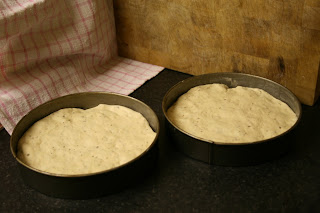So tonight I did as promised and made some delicious pizzas for myself and my wife. Now I shall do my best to explain in writing how I have achieved, over time, something approximating a thin crust pizza in the traditional northern Italian style (I'm never quite satisfied!).
The first thing is to mention the required equipment, as it is not possible to make perfect pizzas with imperfect conditions. The oven is of utmost importance; as most of us don't have wood burning pizza ovens in our kitchens (or even gardens) we need to use the next best thing, and that is a stone and electric 'fan-assisted grill' or a gas oven. If your electric oven does not have a fan-assisted grill then you can use a conventional oven, but the results will be considerably poorer. The stone can be any pressed paving slab made or cut to fit the oven shelf. The reason this is important is that pizzas need to be cooked at high heat from below and above simultaneously; a fresh pizza base will not sit on a normal oven shelf. The next important item is a
platten to transfer the pizza from the work surface to the oven (as I found out the hard way). The simplest and cheapest option I have found is a thin piece of wood with a loose cover of baking paper.
So on to the dough. The pizza dough is so simple there is no need for a detailed recipe. One basically uses twice as much flour as water and aims for 200g of dough per pizza. For example, for the two pizzas I made this evening I used 400g of flour and 200g of water (measure your water on a weighing scale, it's so much more accurate than any measuring jug). Some of you may have noticed that that makes 600g, but I always make an extra portion of pizza dough as a starter for
ciabatta (can anyone guess what my blog will be about tomorrow?!). To the flour should be added about 1/4 tsp of salt per pizza and to the water 2g of yeast per pizza; mix the two combinations
separately and then add the water/yeast mix to a well in the flour and work into a dough. This is going to be quite a stiff dough and the best pizza is made by making it slightly softer e.g. using an extra 15g of water per pizza. Knead it well on a clean work surface until it is smooth, divide into 200g balls and then leave to rise for 3-4 hrs, or until doubled in size, in individual oiled and cling film-covered bowls.
The oven needs to be turned on early and as hot as it will go; I usually leave mine on for about an hour before cooking to warm up the stone sufficiently. The dough should also be left for a second rise, so shortly after turning on the oven (15-20
mins) fill a baking dish with flour, carefully remove the dough ball from its bowl and place it in the flour; flattening and turning with the palm of the hand until it is too big for the dish. Then transfer it to a well-floured work surface and with both hands working palms down and against each other, stretch it out into an even circle, turning as you go. This takes a bit of getting used to, and I had the benefit of a visit to a pizzeria in Italy to see it done, but it is a lot easier than throwing it! Hopefully I shall be able to make some videos in the future so I can explain with a picture what would take a thousand words here.
Once this is done leave them on the floured surface, making sure there is plenty of flour underneath them (you really can't use too much), and prepare the toppings. What you use for toppings is entirely up to you, but for the tomato I have found that
sieving tinned chopped tomatoes to remove the excess juice, adding a teaspoon of sugar, plenty of oregano and then giving them a blitz with a blender to mash the biggest chunks works really well.
All that is left now is to transfer the pizza dough to the
platten by sliding the wood underneath while pulling the baking paper up the surface (start with the baking paper underneath the wood with
only a flap folded over the end that is about to touch the pizza; a more advanced system with the same principle can be found
here). Then add your favourite toppings, tomato first of course) and transfer to the stone in the reverse motion used to scoop up the dough (this takes some practice). The pizza will cook in about three minutes in a very hot electric oven, and it is an easy thing to be tempted to over cook them. Getting them out is much easier and can be done with a fish slice and an asbestos thumb.
I hope this has made some sense, as soon as I am able I shall make some videos to illustrate the process; in the meantime if you have any questions leave them in the comments section.
Happy Baking.





